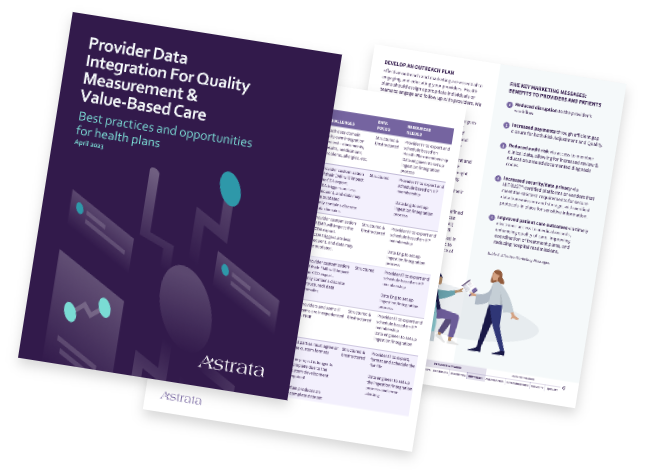Provider Data Integration for Quality Measurement & Value-Based Care
Best Practices and Opportunities for Health Plans
Introduction
Health plans use clinical data to manage population health, reduce costs, improve outcomes, and address health disparities. NCQA is making substantial and ongoing changes to the HEDIS® Quality Measurement program, encouraging the use of clinical data to produce more timely, automated, and actionable information. NCQA’s “Digital Quality” strategy will be an important enabler of value-based care programs and has prompted many payers to accelerate their efforts to aggregate and analyze clinical data.
This white paper identifies some of the immediate steps a health plan can take in preparing to use clinical data at scale, outlines the challenges health plans may encounter, and offers strategies for overcoming them.
Developing a Clinical Data Aggregation Strategy
Clinical data aggregation is crucial for scaling and innovating health plan operations such as quality measurement and improvement, care management, and risk adjustment. A clinical data aggregation strategy lets you support multiple uses of clinical data while avoiding silos and duplicative costs. Your strategy should align with leadership priorities and be supported by business stakeholders and information technology and analytics leaders. Leadership from senior managers and directors should be made aware of aggregated clinical data, encouraged to promote its use, and empowered to seek innovative use cases that benefit their own (and other) teams.
Clinical Data Aggregation Strategies
- Internal Process
- Provider Network
- Implementation
- Define supported use-cases
- Identify appropriate use of programs and infrastructure.
- Establish governance
- Determine critical decision-makers and establish a decision-making framework and process. Depending on the organization, this could be committee-based governance with multiple stakeholders, or a single ultimate owner and decision-maker.
- Prioritize provider data sources
- Rank the order in which providers will be integrated based on defined criteria (e.g., value-based contracts, volume, specific quality challenges).
- Build relationships
- Consider your data exchange efforts as part of a holistic provider relationship.
- Align contracts
- Ensure that language in provider contracts supports the use of clinical data at scale, and that the provider is required to provide medical records at no charge for quality improvement, care management, risk adjustment and audit efforts.
- Align incentives
- Ensure that financial benefits of higher quality rates are shared with providers.
- Develop an outreach plan
- Engage and educate providers about value, incentives, resources, and timelines.
- Establish methods to aggregate provider data
- Determine whether you will develop a network based on direct data flow with providers, use a data aggregator such as a Health Information Exchange (HIE), or a blend of both strategies.
- Invest in centralized infrastructure
- Engage your information technology partners to establish an appropriate architecture for ingesting, storing, and using clinical data by analytics software services.
- Address privacy and security concerns
- Establish appropriate safeguards for the use of data and obtain sign-off from legal/privacy/IT teams.
- Establish processes for maintaining data quality
- Determine which team will be responsible for data quality review, and on what cadence.

